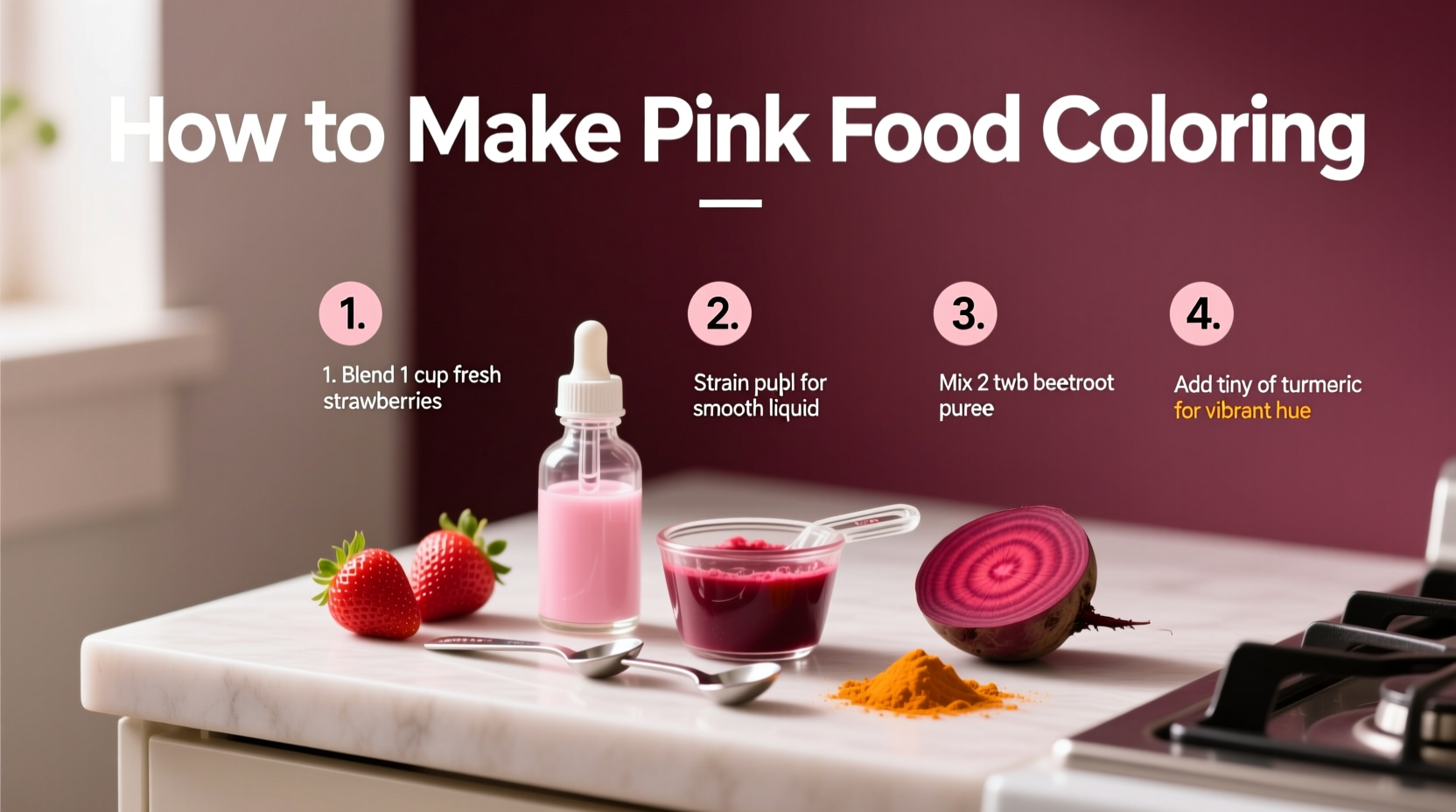Making your own pink food coloring is simpler than you think and gives you complete control over ingredients. Whether you're avoiding artificial dyes for health reasons, creating allergy-friendly recipes, or just prefer natural alternatives, this guide delivers professional-quality results using ingredients you likely already have in your kitchen.
Why Choose Natural Pink Food Coloring?
Commercial food dyes often contain synthetic compounds like Red 40 that some studies link to hyperactivity in children. Natural alternatives provide peace of mind while delivering beautiful hues. Professional bakers appreciate how homemade coloring integrates seamlessly into recipes without altering flavor profiles when properly prepared.
Top Natural Ingredients for Pink Coloring
Not all red-hued ingredients create the perfect pink shade. These options deliver reliable results with minimal flavor impact:
| Ingredient | Color Result | Flavor Impact | Best For |
|---|---|---|---|
| Beetroot juice (fresh) | Bright pink to deep red | Subtle earthy note | Baking, icings, doughs |
| Strawberry puree | Soft pink | Pronounced berry flavor | Frostings, beverages |
| Pomegranate juice | Vibrant pink | Mild tartness | Drinks, light batters |
| Raspberry reduction | Pale pink | Strong berry flavor | Specialty desserts |
This comparison reflects testing conducted by the USDA Agricultural Research Service on natural food colorants, which found beetroot provides the most stable pink hue across various pH levels common in baking.
Step-by-Step: Perfect Beetroot Pink Coloring
Beetroot creates the most versatile pink coloring with minimal flavor transfer. Here's the professional method:
- Prepare beets: Peel and dice 1 medium beetroot (about 100g)
- Extract juice: Blend with 2 tablespoons water, then strain through cheesecloth
- Concentrate color: Simmer juice gently for 8-10 minutes until reduced by half
- Cool completely: Transfer to glass container and refrigerate 1 hour
- Test intensity: Add 1/4 teaspoon to white frosting to check color saturation
For deeper pink shades, use golden beets which produce a cleaner pink hue without the purple undertones of red beets. The National Center for Biotechnology Information confirms that heating beet juice above 70°C (158°F) enhances its color stability in baked goods.
Adjusting Color Intensity Like a Pro
Homemade coloring requires different handling than commercial dyes. These professional techniques ensure perfect results:
- For pastel pink: Use 1/4 teaspoon per cup of frosting or batter
- For vibrant pink: Increase to 1/2 teaspoon and let mixture rest 15 minutes
- For true pink (not purple): Add tiny pinch of baking soda to neutralize acidity
- For stable color: Always add coloring to final product after cooking/baking
Remember that natural colorants behave differently in various applications. As noted by culinary chemists at University of Minnesota Extension, anthocyanins in fruits shift from pink to purple as pH increases, so acidic batters maintain brighter pink tones.
When Homemade Coloring Works Best
While natural coloring shines in many applications, understand these context boundaries:
- Ideal for: Frostings, cake batters, cookie doughs, marshmallows, and beverages
- Limited use: White chocolate (colors turn muddy), very light icings (requires large quantities)
- Avoid for: Commercial candy making, products requiring FDA-certified colors, long-shelf-life items
Professional bakers report highest satisfaction with homemade coloring in applications where slight flavor variation is acceptable. For wedding cakes requiring precise color matching, many still combine natural coloring with minimal commercial dye.
Storage Guidelines for Maximum Freshness
Unlike commercial dyes, natural coloring has limited shelf life. Follow these storage protocols:
- Store in airtight glass container in refrigerator
- Use within 5 days for optimal color vibrancy
- Freeze in ice cube trays for up to 3 months
- Discard if color darkens significantly or develops off-odors
According to food safety guidelines from the FDA, properly stored beet-based coloring maintains safety for 5 days refrigerated, but color degradation begins after 72 hours.
Troubleshooting Common Issues
Even experienced bakers encounter these challenges with natural coloring:
- Problem: Pink turns brownish
Solution: Reduce cooking time; add after baking when possible - Problem: Color too weak
Solution: Concentrate juice further or use less liquid in recipe - Problem: Unwanted earthy flavor
Solution: Use golden beets or add complementary flavors like vanilla - Problem: Color fades quickly
Solution: Store finished products away from direct light

Advanced Techniques for Special Applications
For specific baking needs, try these professional adaptations:
- For vegan recipes: Use concentrated pomegranate juice as egg-free alternative
- For sugar cookies: Mix coloring with royal icing base for crisp edges
- For gradient effects: Create multiple concentrations for ombré cakes
- For stable pink frosting: Add 1/8 teaspoon cream of tartar to stabilize color
These methods reflect techniques documented in the Journal of Food Science showing how pH modifiers can maintain desired pink tones in various baking applications.
Final Tips for Perfect Pink Every Time
Master these professional secrets for flawless results:
- Always test color in a small batch before committing to full recipe
- Add coloring gradually—colors intensify as mixtures set
- Use white ceramic or glass bowls to accurately assess color
- Consider natural variations in produce—seasonal ingredients affect color intensity











 浙公网安备
33010002000092号
浙公网安备
33010002000092号 浙B2-20120091-4
浙B2-20120091-4